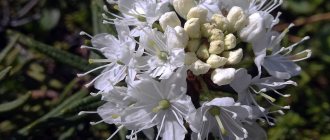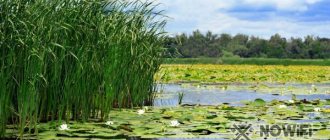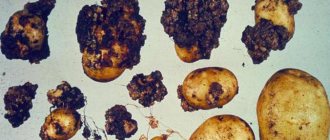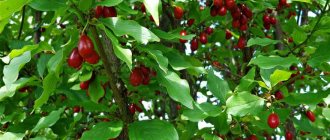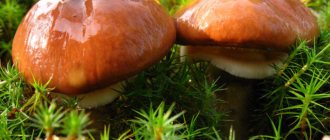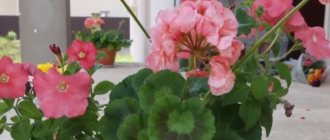- October 19, 2018
- Wild plants
- Svetlana Pavlova
Ledum is a shrub with evergreen foliage that emits a strong aroma during flowering, causing headaches and nervous disorders in humans. This plant is mysterious and paradoxical. Where does wild rosemary grow? It grows in swamps but is drought tolerant. Ledum has narrow leaves to save moisture, despite the fact that the roots are in water. The fact is that once its ancestors grew in Africa, and the plant retained external characteristics characteristic of the flora of a distant sunny continent, while it itself moved to the northern and swampy regions.
Ledum plant, where does it grow?
Ledum is a cold-resistant plant. It can be found in forest and tundra zones, in coniferous swampy forests, forest belts at the foot of mountains, along river valleys and peat bogs. The shrub grows well in poor and acidic soils with strong moisture.
Ledum is distributed throughout Central and Northern Europe. It is found in Japan, China and North America. Significant areas of this unpretentious flowering plant are also found in Central Europe. Where does wild rosemary grow in Russia? Most often it is found in the north of the European part of our country, in Eastern and Western Siberia, as well as in the Far East. In addition, this type of flowering shrub is widespread in the foothills of the Sayan Mountains and Eastern Altai.
Ledums are Siberian rhododendrons
Even now, for me, Siberia is a blank spot on the map of Russia. But thanks to the exchange with Siberian gardeners, there were countless Siberian plants in our garden. It's a pity, but it seems to me that the most interesting of them died. Quite quickly, several of the most graceful ferns, endemic to the Far East, fell out: crooked ferns, edge ferns, etc. The memory of their magical beauty even now gives me a painful feeling of loss.
I received several parcels from the Far East. But the most unforgettable was the one in which the Korean cedar cones came. As soon as the large blue box, striped with the inscriptions “Russian Post”, was opened, the aroma of taiga literally “popped” out of it. Apparently, along with the contents, the air of Sikhote-Alin also came. The smell made my head spin. Out of delight, I sang whatever came to mind. And, of course, this was the most appropriate melody from “Gems”: “Somewhere wild rosemary is blooming on the hills, cedars are piercing the sky...” So I hummed this song all the time while I was planting and watering the sent plants.
That parcel, by the way, arrived in late autumn, in November, when the gardening season was over. So they then came at the same time, from which I concluded that autumn in Sikhote-Alin is soft and long. At this time, our average daily temperatures cross zero, and at night it freezes to minus 6-10. Perhaps this was precisely the reason for the death of the ferns.
In that memorable parcel, among other things, there came a dozen Korean cedar cones, packed in taiga sphagnum. The cones literally stunned me with their beauty and size. Their powerful covering scales were gracefully arched. And all of it is skillfully decorated with streaks of unrealistically beautiful sulfur-yellow resin.
I had only heard before that Korean cedar cones can be so huge. The smallest of the cones sent was 15 cm long, and the largest was about 19 cm. All in all, they were stunningly beautiful. My impressionable nature was so excited that it resulted in strange proposals to my wife.
- Let's go live in Sikhote-Alin! - I begged with very sincere pathos.
My wife is used to my tricks. Another would object, saying, “What are you, grandpa, absolutely!” But mine is pure Pulcheria Ivanovna! She chooses the surest path of assent and deeply hidden irony.
They say - what, come on! “We will build a large environmentally friendly tent far from civilization from cedar wood, which is useful for its secretions. We will live in the taiga, among plant and animal resources, breathe clean air, harvest mushrooms and berries, hunt bears, collect pine nuts... We will swim in a mountain stream together with complacent, cute bear cubs. And in the evenings we will gather around the fire and drink tea brewed with rhododendron leaves.
All these are my own words. But in the mouths of others they sounded mockingly false. And a feeling of self-contradiction began to grow within me. In general, the right way to calm my fantasies was chosen. And I fall silent.
In addition to the cedar cones, the cedars themselves were sent, as well as two types of rhododendrons - Sikhotinsky and pointed, they are also Far Eastern wild rosemaries. It turns out that this was “a set for a live illustration for the song “Ledum”. The only thing missing was some hills, but beyond them it was no longer a matter - my garden on the slope of a forest ravine is nothing short of a hill.
Over time, I acquired other wild rosemaries. And now four species of Siberian rhododendrons grow in our garden - one from Transbaikalia, one from Altai and two from the Far East. There are also three types of cedar pines: Siberian cedar, Korean cedar and dwarf cedar.
Description of the plant
Ledum belongs to the Heather family and is a winter-hardy, highly branched, year-round green plant. Its height reaches from 50 to 120 cm. The root system consists of many additional roots, some of them go into the ground to a depth of 40 cm. The leaves are dark green, shiny, lanceolate with curled edges downwards. Flowers (pink or white) up to one and a half centimeters in diameter, collected in umbrellas.
Flowering begins in late spring and continues throughout June. Young shoots, fruits, pedicels and the reverse side of the leaves are covered with brownish hairs, similar to felt. The small glands of wild rosemary contain an essential oil that has a pungent odor and contains the toxic substance iceol. The fruit consists of a five-locular capsule. The seeds are winged and small.
Reproduction methods
Ledum reproduces well by seed and vegetative methods. In nature, new plants often appear from seeds. They are collected from matured small boxes, which independently crack from bottom to top. From a distance, the achenes resemble tiny chandeliers. Seeds are collected in the fall, but are sown only in early spring. To do this, prepare containers with loose garden soil mixed with sand. The soil should be loose and moist, and also have an acidic reaction. The seeds are distributed on the surface and only slightly pressed into the soil. The container is covered with transparent material and placed in a cool place. The greenhouse is periodically ventilated and watered. Shoots appear in 25-30 days. Grown seedlings are planted in separate peat pots or in another box with a greater distance so that the roots do not get tangled.
Garden plants are conveniently propagated by layering. To do this, flexible branches are tilted towards the soil and fixed in a hole with a depth of 20 cm. The top must be left on the surface. After rooting, the shoot is separated.
A large bush can be divided into several parts during spring transplantation. To do this, the plant is completely dug up, freed from the soil and cut into sections. The cut areas are treated with crushed charcoal. The roots do not dry out and the seedlings are immediately placed in a permanent place.
For cuttings, semi-lignified shoots with 2-3 leaves are cut during the summer. The lower cut is treated with growth stimulants and the shoots are rooted in pots with loose and nutritious soil. The leaves closest to the soil are cut off completely or the leaf blade is shortened. Rooting and adaptation takes a long period, so seedlings are transferred to open ground only next spring.
Types of wild rosemary
There are about ten varieties of the plant, of which only four species grow in Russia. Let's talk about the most common ones:
- Bolotny is the most famous wild rosemary. The height of the plant reaches 60 cm, sometimes there are specimens that stretch up to 120 cm. The leaves are oblong and narrow, their reverse side is covered with villi. It blooms with white or cream flowers collected in umbels. Grows in moss swamps, coniferous forests and peat bogs. Often there are extensive thickets of this shrub. As a rule, the places where wild rosemary grows are very humid. Therefore, its shoots, in contact with the ground, quickly take root.
- Creeping wild rosemary (photo). It’s not difficult to guess where it grows.
A low plant (up to 30 cm) with dense shoots is a typical representative of the northern flora. This species is widespread in Greenland, Kamchatka, Sakhalin, Chukotka, Khabarovsk and Primorsky Krai, and the northern regions of North America. It grows very slowly (about 1 cm per year) and is characterized by high winter hardiness. Flowering is not abundant, small white flowers appear from mid-May to mid-June.
- Large-leaved - frost-resistant shrub, some specimens grow up to 1.3 m. Where does wild rosemary grow, in what zone? It grows in Eastern Siberia, Primorye, Sakhalin, and the Far East in peat bogs. Abundant flowering in May-June. Seed ripening occurs in August.
Creeping wild rosemary (Ledum decumbens (Ait.) Small.)
Squat creeping shrub. The leaves are linear, narrow and small (2 cm long and 2 mm wide); transversely grooved above; with the edge rolled up so much that the underside of the leaf is almost completely covered.
Creeping wild rosemary is no less common than marsh rosemary. Distributed in Primorye and the Amur region, on the Okhotsk coast, Kamchatka, Sakhalin, Commander and Kuril Islands. It grows in dry spruce forests and on sandy hills, as well as among creeping cedar trees on rocky scatterings and on chars. Blooms in May-July.
Useful properties of wild rosemary
Despite the fact that wild rosemary contains toxic substances, it has been used since ancient times to treat many ailments. The essential oils contained in the plant have a bactericidal, expectorant and bronchodilator effect. A decoction of wild rosemary is used to treat the kidneys, liver, lungs and heart.
Various preparations based on this plant are used during influenza epidemics, acute respiratory infections and acute respiratory viral infections, and are also used to treat scrofula and rheumatism. Leaves and shoots are brewed and drunk as a sedative and sleeping pill. And an infusion of wild rosemary in oil saves you from a runny nose. Where wild rosemary grows (a photo of which can be found in the article), it is collected and dried. Medicinal raw materials are used for the production of medicines widely used in official medicine and veterinary medicine. In addition, it is used to combat harmful insects: mosquitoes, cockroaches, moths, ants, bedbugs.
All wild rosemaries are poisonous plants
If you have at least once picked blueberries near wild rosemary thickets, then you know that such berries are slightly bitter. The reason for this is the volatile essential oil of wild rosemary, deposited on the surface of the berries. Although some authors point out the possibility of poisoning from such blueberries, such cases have not been described in the medical literature.
Nevertheless, all wild rosemaries are poisonous, and to varying degrees. In addition, the reaction to poisoning is different for all people. Therefore, both when taken orally and when used externally, an overdose should not be allowed. Even cases of poisoning with wild rosemary honey have been described. This honey is also called “drunken honey.”
Moreover, both mild and severe poisoning are known. In mild cases, wild rosemary poisoning is manifested mainly by sharply increased drowsiness and general weakness. As a rule, it goes away quickly and without treatment. It's just dangerous to drive a car in this condition.
In severe cases, the symptoms are much more serious. Along with nausea and vomiting, there is increased sweating and rapid heartbeat. Blood pressure drops sharply. There is a feeling of suffocation, sometimes quite strong.
As with any other poisoning, first aid should begin with gastric lavage with an aqueous suspension of activated carbon. That is, crush 50-60 tablets of activated carbon and pour the powder into a glass of water. Give the resulting suspension to the victim to drink. Next, give warm water to drink, because with vomiting and diarrhea, the body becomes dehydrated. All this must be done before the ambulance arrives.
We never think about the fact that many beautifully flowering plants in the taiga can be poisonous. Blooming rosemary and everyone's favorite lily of the valley are very attractive in spring and summer; aconite and even hellebore. Be careful!
Literature:
- Nechaev, Andrey Petrovich. Green arrows. Stories of an Amur botanist. – 2nd ed., rev. and additional – Khabarovsk: Book publishing house, 1980. – 320 p. – (Natural world of the Far East). Artist A. N. Posokhov.
- Fruentov Nikolay Konstantinovich, Kadaev Gennady Nikolaevich. Poisonous plants. Medical toxicology of plants of the Far East. Khabarovsk, Kn. Ed., 1971.
- Fruentov, Nikolai Konstantinovich. Medicinal plants of the Far East. 3rd edition, expanded and expanded. – Khabarovsk: Book. Publishing house, 1987. – 352 pp., 0.5 l. ill.
- Shreter, Alexey Ivanovich. Medicinal flora of the Soviet Far East. – M.: Medicine, 1975. – 328 p.
Average rating: (Total votes: 2 )
Growing wild rosemary
Ledum, due to its specific properties, is not often used for growing in personal plots. However, if you decide to decorate your area with it, then wild rosemary is suitable for cultivation in the garden. You should not dig it up in the swamp and plant it on the site, as it will die. It is best to purchase it at a nursery. The plants exhibited there are already adapted to the conditions of the garden plot. Planting and caring for wild rosemary is not difficult. He is not whimsical and does not require much trouble. Favorable time for planting is spring. For planting material, you need to make a hole 40 cm deep. To create a composition, you can place several bushes at a distance of 50 cm from each other. Where wild rosemary grows, the soil is usually acidic. Therefore, planting holes are filled with moss peat, coniferous soil and sand. A drainage of sand or pebbles is placed at the bottom, and mulching with peat is done on top.
Do we know everything about wild rosemary?
By the way, the antiscrofulous properties of wild rosemary (as, by the way, both diaphoretic and anthelmintic) have not been tested in clinical conditions. Many questions still remain unanswered. Thus, a study of some forms of DV showed that wild rosemary moderately reduces blood pressure. However, the Yakut wild rosemary has the opposite effect - a vasoconstrictor.
In addition, it is not yet known how constant the composition of the active ingredients of wild rosemary is. In the narrow-leaved form, for example, one of the important medicinal components is missing - ice. However, this substance was found in plant samples from Primorye. That is, there are differences between plants harvested in different regions of the Far East. Something to think about! Is not it?
It must be said that only wild rosemary has undergone detailed study. Other Far Eastern species have remained largely unstudied chemically to this day.
Care and reproduction
In nature, wild rosemary grows on poor soils, but in the garden, for rapid growth and abundant flowering, fertilizing is done once a season, in the spring - with mineral fertilizers. During the hot summer months, wild rosemary is watered generously once a week.
After watering, the soil is loosened and mulched with peat. There is no need to prune the plant; only damaged branches are removed. Ledum is resistant to pests and diseases. Under natural conditions, where wild rosemary grows (the plant in the photo), propagation occurs by seeds and root shoots, and at home, cuttings are also used. Cuttings are carried out in the summer. The shoots are cut and soaked for a day in a Heteroauxin solution. Then they are washed and planted in boxes. Roots appear only the next year.
2.Ledum - planting and care
2.1.When it blooms
April – July.
2.2.Reproduction - growing from seeds
Ledum can be planted with seeds sown in February or March. Germination is better for fresh seeds, so if suitable conditions are available, they are sown in the fall, immediately after ripening. They come out quite slowly. It is also possible to propagate indoor wild rosemary by half-ripe cuttings 5–8 cm long, which are rooted in July–August.
↑ Up,
2.3.Transplanting wild rosemary
Young plants as they grow - in the spring , every year, adult plants - once every 2 - 3 years, or simply change the top layer of soil for this flower.
↑ Up,
2.4.Care, pruning
Trim the shoot tips of young plants to encourage branching. Thin the crown of mature plants to provide the plant with more light and increase air circulation. Old plants can be rejuvenated by drastic pruning, but it is recommended to remove no more than 1/3 of the branches at a time.
↑ Up,
2.5.House maintenance - temperature
Tolerates a wide range of temperatures during periods of active growth. In winter, when growing wild rosemary, a cool dormant period at a temperature not exceeding 10° C
2.6. Diseases and pests
Plants that do not receive enough light may become pale, have fewer leaves and become elongated, grow more slowly, and do not bloom as profusely. In direct sunlight, the plant may wilt and the leaves may become sunburned. Of the harmful insects, wild rosemary can be harmed by spider mites and bedbugs.
↑ Up,
2.7. Priming
Sandy, loamy or clayey with an acidic pH . Ledum can grow in very acidic soils, peat, sand, tree bark compost or coniferous soil.
2.8.Lighting for home wild rosemary
The shrub can grow in full shade , partial shade , but will be denser in a place with good lighting without direct sun rays.
↑ Up,
2.9.Fertilizer
Young plants need fertilizers containing phosphorus to develop a strong root system. Fertilizers with a high nitrogen content contribute to the growth of green mass, but do not overfeed wild rosemary with nitrogen - flowering will be weaker.
↑ Up,
2.10. Watering wild rosemary
Prefers moist soil at any time of the year.
2.11. Spraying
Home rosemary will feel better if it is periodically sprayed.
↑ Up,
2.12.Purpose
Decorative wild rosemary can be used for cutting - it does not lose its freshness for a long time at home, in a vase, but it should be used with caution due to its specific smell. You definitely shouldn’t leave a vase with this fragrant plant indoors overnight. Ledum in the garden will add a bright accent to any flower bed or flower garden.
↑ Up,
2.13.Note
The plant has many medicinal properties . Leaves and young flowering shoots have an astringent, diaphoretic, disinfectant, diuretic, and laxative effect. In summer, the plant releases poisonous essential oils from its leaves into the air; its smell can cause headaches. Often, pickers of marsh berries, such as blueberries, suffer from wild rosemary blooms. Symptoms of poisoning include dizziness, headache, and loss of coordination.
↑ Up,
Hydroponics.
Procurement of raw materials
The collection of medicinal raw materials begins at the end of July and continues throughout August. When preparing, you must use gloves and a gauze bandage. You should not stay near the bush for more than an hour and a half. Leafy shoots up to 10 cm long are cut off. After this, they are collected in small bunches, tied up and hung down in inflorescences. Drying is carried out in a well-ventilated area without access to sunlight. An attic is suitable for these purposes. The grass is also dried in special dryers.
The air temperature can be from 10 to 55 degrees. The duration of air drying is two weeks, and the shelf life of the raw materials is up to three years. You cannot use a living room for drying; the smell from the grass provokes vomiting, dizziness and nausea. The finished dry raw materials are placed in paper bags or cloth bags, and best of all - in glass jars with tight-fitting lids.
ethnoscience
The healing properties of wild rosemary have been known since time immemorial. In Rus', the first mentions of it date back to the 17th century. Healers even have a book written by one of the traditional healers, which contains all the effective and popular recipes with wild rosemary at that time. It's called "All about the benefits of stinking heather."
Currently, interest in this shrub does not fade. It is used not only in folk medicine, but also in official pharmacology. It has been scientifically proven to have bactericidal and anti-inflammatory properties.
A decoction of wild rosemary has expectorant, thinning and phlegm-removing properties. It is taken for such serious diseases as tuberculosis, whooping cough, bronchitis and other bronchopulmonary diseases, as well as gout and rheumatoid pathologies.
In addition, folk healers prescribed wild rosemary decoction for heart failure, diseases of internal organs (kidneys, liver), and hypertensive crisis. Used as an antihistamine in children and adults.
The above-ground part of wild rosemary has sedative, hypnotic, disinfectant and wound-healing properties. The leaves are brewed and the nasal sinuses are washed with this decoction. Compresses are also made with the decoction for various skin lesions and dermatological diseases, as well as for frostbite and swelling. By adding it to baths or making lotions with wild rosemary decoction, you can improve blood flow in the extremities.
Tips for care and reproduction
Experienced gardeners living in places where wild rosemary grows give the following recommendations:
- The plant is unpretentious to lighting, it will grow even in a shady place and will not die, only the flowers will be slightly smaller.
- The easiest way to propagate is by dividing the bush.
- Abundant watering is necessary only in severe drought.
- You should not grow wild rosemary in small front gardens or near apiaries. Honey collected from the flowers of the plant can cause poisoning.
When planting creeping wild rosemary, no care is required. It grows on rocky slopes and reproduces well by seeds.
The success of the business is determined by peat and mycorrhiza.
It is difficult to understand why wild rosemary bonfires are still not burning in every front garden. After all, these are native Russian species, quite stable in central Russia. In any case, they are one of those few rhododendrons that rarely disappoint anyone, unless, of course, you make gross mistakes in choosing the location and composition of the soil.
Landing place. A location well protected from winds is desirable. In any case, it is so quiet that in winter the snow does not blow away, but rather accumulates. The soil may initially be light loamy or sandy loam; groundwater should not come very close. Spring flooding with melt water is unacceptable.
The soil. In fact, half of all rhododendron problems are solved by soil choice. Most rhododendrons prefer humus-rich acidic soil with a pH of 4-4.5. In practice, this is easy to achieve using high-moor peat. For example, in our garden everything was resolved after I poured a half-meter layer of peat on the initially sandy loam soil and shoveled it all.
I advise anyone who wants to master rhododendrons to buy a high peat machine. Although it is more expensive than manure, it contains much more active organic matter, so it does not disappear from the soil like manure. In addition, its acidity disappears in the air, under the influence of microorganisms and bacteria. So it will be useful not only for rhododendrons.
And yet, it is advisable to set aside a separate area for heathers, including rhododendrons. Not only heather plants will grow well there, but also many other crops with similar preferences. For example, large-leaved and paniculata hydrangeas, etc.
Mycorrhiza. All heathers are friendly with fungal mycorrhiza, thanks to which, and as is believed to be of mutual benefit, they receive additional nutrition. Mycorrhizae are hyphae (or rhizoids) of fungi that grow in the litter of pine forests. Mycorrhiza of fungi growing where plants such as heather, lingonberries, wild rosemary, etc. are present are especially useful. Hyphae (note that mushrooms are not necessarily cap mushrooms, there are many others) literally entangle the underground space with their threads, penetrating into the roots of all trees and shrubs growing with them.
Mycorrhiza should be brought from the forest. Therefore, if you want to succeed with heathers, a mandatory item when visiting a coniferous forest should be to bring heather soil from there. And, by the way, in order not to harm the mycorrhiza, you should not dig up or even loosen the soil under heathers.
Precautionary measures
As already mentioned, the toxic substances contained in wild rosemary can negatively affect human health. Essential oils are released especially intensely during flowering. If you stay near a flowering plant for a long time, dizziness, nausea, headache and even paralysis of the limbs occur. Exceeding the dosage of wild rosemary preparations leads to severe poisoning, vasospasm, disruption of the gastrointestinal mucosa, and respiratory failure. People suffering from:
- hypertension;
- kidney and liver diseases;
- disorders of the autonomic system.
Pregnant and lactating women are advised to avoid flowering wild rosemary bushes. And for those who drive a car, it is better not to drive after taking medications from wild rosemary. Without a doctor's recommendation, you should not use medications that contain this plant.
Use in everyday life
The marsh wild rosemary shrub is poisonous. In large doses, the plant causes paralysis of the respiratory organs and heart muscle, dizziness, and general discomfort.
In everyday life, forest rosemary leaves are used as an insecticidal agent to kill insects, bedbugs, mosquitoes and flies. The branches of the plant are placed in the wardrobe to protect clothes from moths. Essential oil is used in the textile industry, perfumery and soap making. Together with tar, it is used to tan leather. The herbal decoction is given to horses after drinking and for colic, to pigs for epidemic diseases, and to cows for bloating. Marsh wild rosemary has a stupefying effect on livestock. The only exception is goats, for them it is harmless.
Features of collecting wild rosemary
Herbalists do not collect all parts of wild rosemary. The most useful from the point of view of preparing harvests are the young parts of the stem, green intact leaves and those fruits that are located on the shoots. Professional herbalists know what wild rosemary looks like, because thanks to its clear description and characteristic smell, wild rosemary is easy to identify.
The largest amount of essential oils, which are especially valuable in the plant, is contained in the young part of the shoots no older than 2-3 years. The collection is made during flowering, when there are young shoots and flowers containing the greatest amount of useful substances.
The harvesting of grass is done strictly by hand. The required part breaks off, the root system should not be damaged. Otherwise, the marsh rosemary will die. After collection, the marsh rosemary is left for 3-5 years until it is completely restored. This will allow you to regularly collect complete raw materials for preparing mixtures. It is recommended to harvest raw materials in dry, not too sunny weather, after the dew has disappeared. This will allow you to retain the maximum amount of nutrients in it.
Popular: Two effective ways to graft a rose onto a rosehip
Preparation of raw materials
The assembled parts must be dried for long-term storage. The beneficial properties of swampweed are preserved when properly stored for 3 or more years. The best place for drying is a ventilated room, protected from direct sunlight. Stems and shoots dry well under a canopy.
The drying layer should not be more than 15 cm. If the workpiece is produced in a dryer, then the optimal temperature will be 40°C. This will preserve all the beneficial qualities, prevent the loss of essential oils and reduce their effectiveness.
Daily turning of the dried raw materials will ensure a uniform reduction in the amount of moisture for better subsequent storage. It is important not to inhale concentrated vapors when drying wild rosemary in a closed room.
Compound
Since it is the composition that determines the value of any plant, study the content of useful substances in swampweed to understand the possibilities of its use. The interesting chemical composition and high content of essential oils in shoots, leaves and fruits determines a wide range of effects on human health. Proper collection, preparation and storage of collected raw materials allows you to preserve the beneficial properties of marsh grass for a long time (not to be confused with marsh marigold).
It contains the following substances:
- Tannins. Their purpose is to stop bleeding and have an astringent effect;
- Flavonoids are substances of plant origin that have a positive effect on the condition of the walls of blood vessels. This improves their overall functioning and reduces permeability. increases tone;
- Essential oil, which contains cymol, palustrol, ledol, geranyl acetate. Of these organic compounds, iceol has the greatest effect: it has an expectorant, relaxing effect;
- Arbutin glycoside has antiseptic and antimicrobial effects. Thanks to it, the active reproduction of Staphylococcus aureus is stopped and the growth of pathogenic microflora is suppressed.
The composition of this herb with pronounced qualities is characterized by a high content of essential oils. This requires thoughtful and careful handling of raw materials.
Areas of use
Positive effects from it were manifested in many lesions of internal organs. Bolotniki today are widely used for treatment and healing purposes. The composition of its parts allows it to be included in mixtures for the treatment of the following diseases:
- When coughing. A dry, exhausting cough without mucus discharge, as well as bronchitis, sore throat, and asthma, can be perfectly cured with regular and standardized use of formulations containing wild rosemary. The positive effect is achieved due to pronounced relaxation of the bronchi, which facilitates the release of sputum from them. The total warming and enveloping effect provides relief of the patient’s general condition;
- Poisoning of the body, which is caused by the active proliferation of pathogenic microflora in the intestines and digestive organs;
Popular: Bush-shaped tolmia for carpet decoration of home or garden
- In order to lower and stabilize blood pressure. Used for cough syndrome, which is accompanied by high blood pressure;
- It copes well with the excessive proliferation of pathogenic microflora (Staphylococcus aureus), and is used to disinfect skin lesions and long-term non-healing wounds. Eliminates septic lesions of the epidermis.
They can be used for a long time: to maintain normal breathing in asthma, pulmonary tuberculosis. The indications for its use are quite extensive; the main ones should be the elimination of the manifestations of all diseases accompanied by cough syndrome.
Additional uses
There are a number of diseases for which the use of herbs and plant flowers is also recommended. In these cases, they serve as an excellent supportive agent and are used in combination with other drugs.
Having a disinfectant effect, preparations based on young shoots, leaves and flowers of swampweed are prescribed for:
- dysentery;
- lesions of the genitourinary system;
- diabetes mellitus
The listed pathologies are accompanied by inflammatory processes and the penetration of infection into the system. Preparations based on swampweed eliminate the development of pathogenic microflora and signs of inflammation. Also, in the treatment of genitourinary lesions, a diuretic effect is noted, which also has a positive effect on the body
Plant materials, prepared as required, are added to ointments, tinctures, and rubs. Such external remedies are prescribed for skin diseases, acne, a tendency to form pimples and deep boils.
To treat arthrosis and arthritis, ointments are applied to joints in cases of severe pain and decreased mobility. Parallel intake of tinctures based on leaves and shoots orally enhances the positive effect of the treatment. Joint diseases are weakened by regular application of compresses based on ointments with wild rosemary leaves and flowers; a pronounced result of treatment is evident when physical therapy is prescribed.
Attacks of radiculitis are quickly blocked when an ointment based on wild rosemary is applied to the lumbar area. To stabilize the condition, it is recommended to use ointments regularly, even during remission. Frostbitten tissues are restored with normal exposure to swampweed essential oils; ointments can also be used that are carefully applied to frostbitten parts of the body.
In cosmetology, essential oils from flowers and leaves help fight inflammatory processes on the skin, eliminating acne, age spots, and minor mechanical damage. Juvenile acne becomes less pronounced when the tincture is applied externally to the affected areas in parallel with its internal administration.
Botanical description of wild rosemary
Marsh wild rosemary is an evergreen shrub no more than 60-70 cm high. It is characterized by recumbent stems from which numerous branches rise. The creeping stems of the plant have the ability to take root. The shoots have slight pubescence of a rusty color. Old shoots are covered with bare grayish-green bark.
The leaves of wild rosemary have an alternate arrangement. Their shape varies from linear to oblong-elliptical. The length of the leaf blades ranges from 1 to 4 cm. The tips of the leaves are slightly blunt or pointed.
The flowers are collected in umbrella-shaped inflorescences with a diameter of about 5 cm. The color of the inflorescences is pure white or with a slight reddish tint. The smell of flowers is very rich, intoxicating. The fruits of the swampweed are five-locular capsules that, when ripe, split along the side seams. The flowering period is very extended. Depending on weather conditions, it can last from May to July. The marsh rosemary is endangered. In the Lipetsk region it was even included in the Red Book.
Application of wild rosemary
Although wild rosemary is considered a poisonous plant, it has found wide use in the manufacture of drugs in folk and conventional medicine. Due to its chemical composition, this plant is used as a bactericidal, anti-inflammatory, hemostatic, diaphoretic, wound healing and expectorant.
The plant is used in medicinal preparations:
- For the treatment of bradycardia, that is, it increases the heart rate and pulse.
- For pulmonary and infectious diseases such as tuberculosis. Effective for bronchial asthma, bronchitis, inflammation of the respiratory tract.
- Used as a bactericidal and antiviral drug for whooping cough, diphtheria and other diseases.
- As an antispasmodic for exacerbation of gastrointestinal diseases, cholecystitis.
- As an anti-inflammatory agent for skin diseases, inflammation of the eyes, and female reproductive organs.
- For joint diseases, rheumatic pain.
Wild marsh rosemary
This type of wild rosemary belongs to the heather family. From this family, plants belonging to wild rosemaries are distinguished:
- Marsh wild rosemary
- Greenlandic
- large-leaved
Marsh wild rosemary is an evergreen shrub. The height of the shoots reaches 150 centimeters. The shoots are covered with pubescence of a “rusty” color. Individual bushes reach one meter in diameter. The curled, lanceolate, dark, shiny leaves of the bush are curled down. This wild rosemary blooms en masse at the end of May. The flowers are beautiful, white, sometimes light pink, in umbels of many flowers. During flowering, essential substances are released into the atmosphere. These substances have a toxic effect on the human body. During flowering, their concentration in the air reaches its peak. The plant is completely poisonous, not just the flowers. Being near wild rosemary for several minutes, a person begins to experience a severe headache, nausea, and dizziness. You can lose consciousness if you inhale the aroma of wild rosemary for too long.
However, not only the plant is poisonous, even the honey collected from these flowers is poisonous. So, before you start growing this heather for decorative purposes, you need to think about the consequences. Even animals experience exhaustion and weakness after prolonged contact with bushes, as there is multiple evidence from professional hunters. After flowering until mid-June, the period of seed ripening begins.
The capsule-shaped fruit ripens in August. The plant reproduces in two ways: by root shoots and seeds. Ledum is winter-hardy in any conditions. However, shoots on open ground that are not covered with snow die. Shrubs growing in non-snowy areas have a beautiful and even crown shape, as if trimmed by a master. The inflorescences at the edges are larger than in the center. But. Flowering occurs simultaneously. Mass flowering of marsh and other wild rosemaries of the heather family does not occur every year, but once every 4 years. This is due to the long growing season.
Ledum reproduces well by seeds in open forests and areas without moss. Grows slowly in any conditions. The lifespan of the root system is not much more than thirty years. But in mossy, marshy areas, wild rosemary does not survive for long. It is gradually being pulled into the thickness of the moss due to the constant growth and rise in the level of the swamp. As a result, the root system finds itself in conditions deprived of oxygen and in very humid conditions.
Then the roots die off, turning into a thick layer of swamp and peat, and adventitious surface roots appear on living shoots (if any). If the roots are not covered with snow for the winter, then the plant does not survive. When wild rosemary blooms, on a bright moonlit night the landscape appears enchanting and magical. Flowering rosemary bushes, shrouded in an alluring, deceptive and so pleasant aroma, attract you to them. I immediately remember fairy tales about ominous and beautiful swamps, undines, revived drowned women, forest dwellers and magic.
Habitats
The most common is marsh wild rosemary, found everywhere in different parts of the world, where coniferous forests, mountain streams, forest-tundra, mountain thickets, and dwarf cedar forests are located. There is a lot of wild rosemary in the swamps of Belarus.
Ointments, tinctures, compresses
In pharmacies you can purchase ready-made preparations based on wild rosemary. Dried raw materials are also sold, which can be used for making your own preparations. One should not forget about the need for strict dosage of plants: with excessive intake of essential oils and glycosides from medicinal raw materials into the body (externally or internally), negative manifestations are likely to occur. These may be symptoms of poisoning in the form of dizziness, vomiting, digestive disorders, as well as skin rashes and irritation of the epidermis.
Popular: Perennial grass miscanthus for decoration in landscape design
To prepare medications yourself, you should adhere to the recommended dosage of each component. Additional components can be animal fat: vegetable or butter, interior or goose fat, and other elements. Other herbs added to the composition will increase the effect.
Preparation of ointment for external use
An ointment that shows results for joint damage and skin diseases (pustular and acne, acne, inflammatory processes, eczema, long-term non-healing wounds) can easily be made independently.
For this purpose, animal fat is used, which is taken as the basis of the ointment. 100 grams of goose fat are mixed with 200 g of butter (can be melted). Dry swamp herb is added to the mixture. Mixing the components is carried out in a certain way:
- First, a layer of grass is placed in the container;
- on top there is a layer of fat and oil;
- then another layer of grass and so on until the very top of the dish.
Now the container is placed in a preheated oven. Heating continues for three hours. After this, the resulting mixture is filtered through a sieve: this removes the remaining herbs. The resulting ointment is cooled at room temperature and can be used. The ointment can be applied to wounds and skin lesions, for eczema, application three times a day to sore spots until the main symptoms are eliminated.
Preparing the decoction
A decoction of leaves and flowers is used for dry cough, asthma, bronchitis, and pulmonary tuberculosis. To prepare it, 1 tablespoon of fresh or dry raw materials is poured with boiled warm water (250 ml) and left to infuse overnight. In the morning, the mixture is heated in a water bath for 40 minutes, then filtered and added to a glass of warm water. Oral administration is performed three times a day after meals. Tonsillitis, colds, and bronchitis can be easily cured by taking this decoction for no more than 2.5 weeks. A longer period of time is not recommended due to possible overdose.
Currently reading:
- How to use vermiculite for indoor plants and seedlings
- Using perlite in the garden and for indoor plants
- Choosing cucumbers for open ground according to your preferences
- Beautiful flowering of epiphyllum after planting in a pot
Share the news on social networks
About the author: Lyudmila Vasilievna Nosikova
Agronomist of the state agricultural enterprise "Garovskoe" of the Khabarovsk region of the Khabarovsk Territory.
Why is wild rosemary so useful?
The main value of wild rosemary lies precisely in the essential oils in which its aerial part is so rich. When wild rosemary blooms, it has the highest possible oil content. That is why the best time to collect is during the flowering period. In addition, the amount of oils and its concentration depends on the area of growth.
Iceol is a toxic substance that wild rosemary essential oils are rich in. It is this that gives the greenish tint, thickness and burning taste to the essential oil. But besides this, iceol has antitussive and enveloping properties, so it is completely wrong to talk only about its uselessness. Many medications have been created on its basis - bactericidal, sedative, and stabilizing high blood pressure. Also, blooming wild rosemary is a storehouse of other useful vitamins and microelements, ascorbic acid, phytoncides and flavonoids.
Ledum in collections
Ledum is used in collections together with other plants. To treat cough, 70 grams of raw material are mixed with 30 grams of nettle. Then two spoons of the mixture are steamed with half a liter of boiling water and left for half an hour. The composition is taken two spoons up to five times a day.
For stool problems and pathologies of the digestive system, use a mixture of 20 grams of marshmallow root and 30 grams of wild rosemary. Two spoons of the composition are steamed with 500 ml of boiling water and left for 40 minutes. Then the product is heated in a water bath for 15 minutes. Take a quarter glass up to six times a day.
For cystitis and urethritis, use: five parts each of wild rosemary, St. John's wort, pine buds, four parts horsetail and three parts mint. Mix everything, brew two tablespoons of the mixture with half a liter of boiling water. Take a quarter glass five times a day.
Choosing a place and soil for wild rosemary
Ledum can take root almost anywhere, but it is better to plant it in the shade, as it does not like sunlight.
Lush inflorescences look advantageous against the background of spruce, pine or thuja, so for a decorative effect you can plant them next to these plants. Since its homeland is a swamp, the soil for rosemary, especially swamp, should be acidic and loose. To do this, the planting hole is filled with a mixture of high-moor peat (3 parts), sand (1 part) and coniferous soil or tree bark (2 parts). Species such as large-leaved wild rosemary and Greenland rosemary can grow even on poor and sandy soils; for them, the substrate is prepared according to the same principle, but with a predominance of sand.
